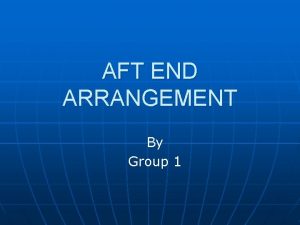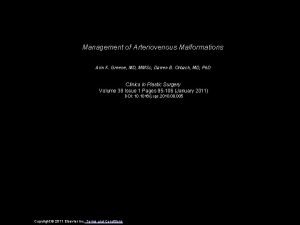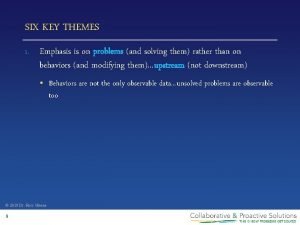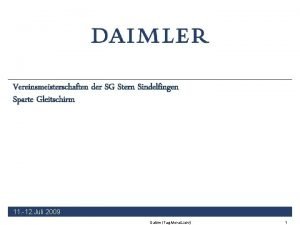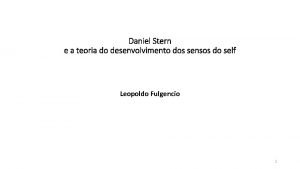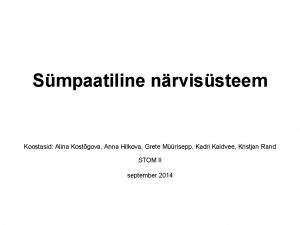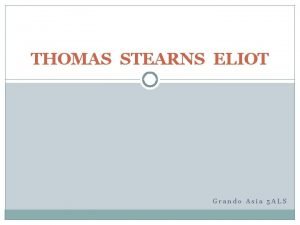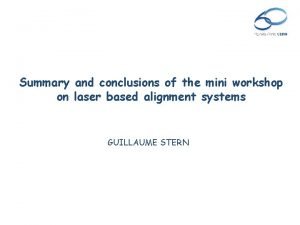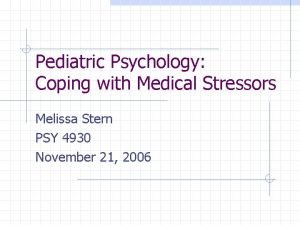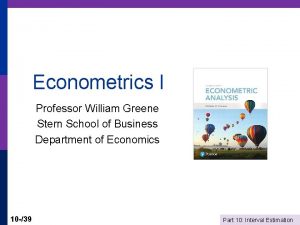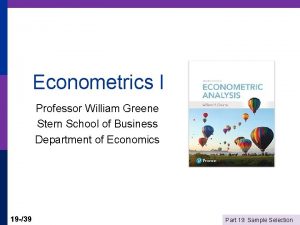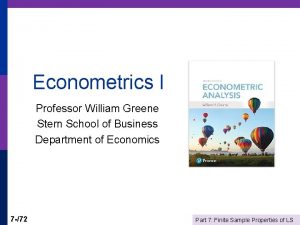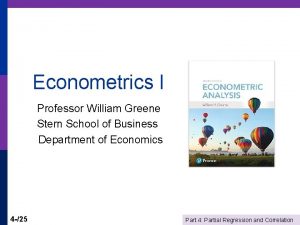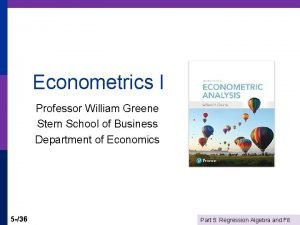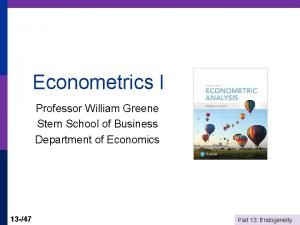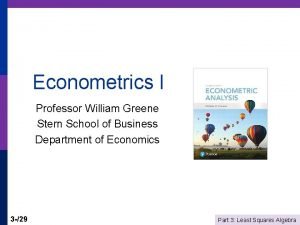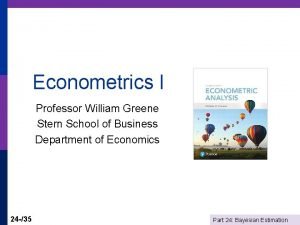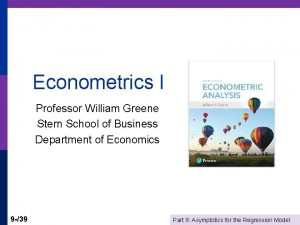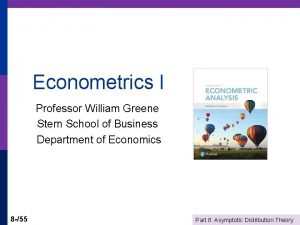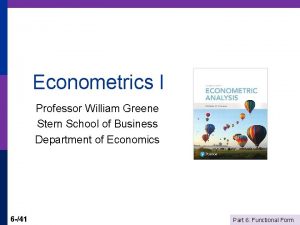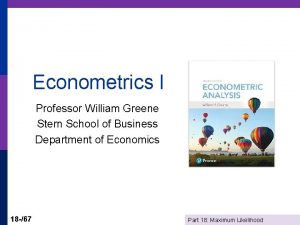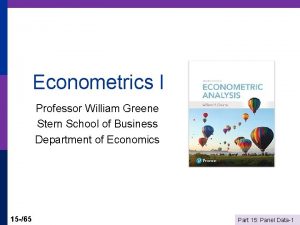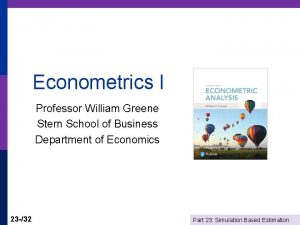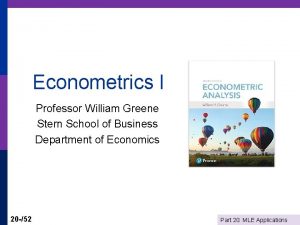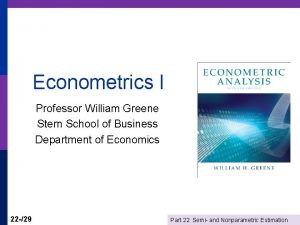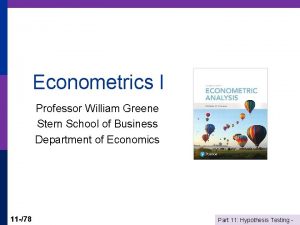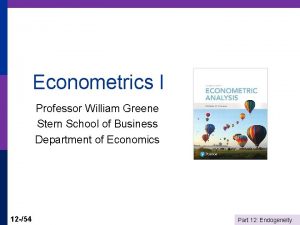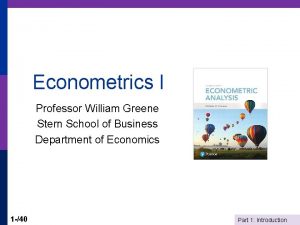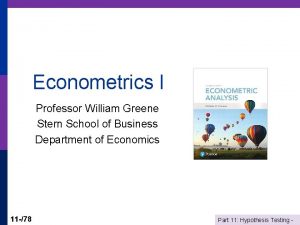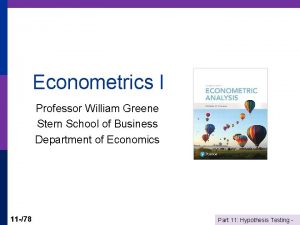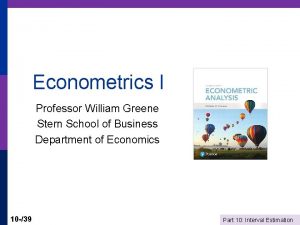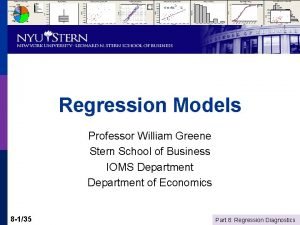Econometrics I Professor William Greene Stern School of






![50 Observations on P and Q Showing Variation of P Around E[P] 2 -7/47 50 Observations on P and Q Showing Variation of P Around E[P] 2 -7/47](https://slidetodoc.com/presentation_image/5acaa7075e4497373e70c9ec38657042/image-7.jpg)
![Variation Around E[P|Q] (Conditioning Reduces Variation) 2 -8/47 Part 2: Projection and Regression Variation Around E[P|Q] (Conditioning Reduces Variation) 2 -8/47 Part 2: Projection and Regression](https://slidetodoc.com/presentation_image/5acaa7075e4497373e70c9ec38657042/image-8.jpg)




![Regression and Projection Does this mean E[y|x] = + x? n No. This is Regression and Projection Does this mean E[y|x] = + x? n No. This is](https://slidetodoc.com/presentation_image/5acaa7075e4497373e70c9ec38657042/image-13.jpg)











![Representing the Relationship p p Conditional mean function is : E[y | x] = Representing the Relationship p p Conditional mean function is : E[y | x] =](https://slidetodoc.com/presentation_image/5acaa7075e4497373e70c9ec38657042/image-25.jpg)

![Summary p Regression function: E[y|x] = g(x) p Projection: g*(y|x) = a + bx Summary p Regression function: E[y|x] = g(x) p Projection: g*(y|x) = a + bx](https://slidetodoc.com/presentation_image/5acaa7075e4497373e70c9ec38657042/image-27.jpg)



![Linearity Simple linear model, E[y|x] =x’β p Quadratic model: E[y|x] = α + β Linearity Simple linear model, E[y|x] =x’β p Quadratic model: E[y|x] = α + β](https://slidetodoc.com/presentation_image/5acaa7075e4497373e70c9ec38657042/image-31.jpg)
![Linearity means linear in the parameters, not in the variables E[y|x] = 1 f Linearity means linear in the parameters, not in the variables E[y|x] = 1 f](https://slidetodoc.com/presentation_image/5acaa7075e4497373e70c9ec38657042/image-32.jpg)

![Uniqueness of E[y|X] Now, suppose there is a that produces the same expected value, Uniqueness of E[y|X] Now, suppose there is a that produces the same expected value,](https://slidetodoc.com/presentation_image/5acaa7075e4497373e70c9ec38657042/image-34.jpg)





![Zero Conditional Mean of ε p E[ |all data in X] = 0 p Zero Conditional Mean of ε p E[ |all data in X] = 0 p](https://slidetodoc.com/presentation_image/5acaa7075e4497373e70c9ec38657042/image-40.jpg)
![The Difference Between E[ε |x]=0 and E[ε]=0 With respect to , E[ε|x] 0, but The Difference Between E[ε |x]=0 and E[ε]=0 With respect to , E[ε|x] 0, but](https://slidetodoc.com/presentation_image/5acaa7075e4497373e70c9ec38657042/image-41.jpg)






- Slides: 47

Econometrics I Professor William Greene Stern School of Business Department of Economics 2 -/47 Part 2: Projection and Regression

Econometrics I Part 2 – Projection and Regression 2 -/47 Part 2: Projection and Regression

Statistical Relationship Objective: Characterize the ‘relationship’ between a variable of interest and a set of 'related' variables p Context: An inverse demand equation, p n n 2 -3/47 P = + Q + Y, Y = income. P and Q are two random variables with a joint distribution, f(P, Q). We are interested in studying the ‘relationship’ between P and Q. By ‘relationship’ we mean (usually) covariation. Part 2: Projection and Regression

Bivariate Distribution - Model for a Relationship Between Two Variables p p p 2 -4/47 We might posit a bivariate distribution for P and Q, f(P, Q) How does variation in P arise? n With variation in Q, and n Random variation in its distribution. There exists a conditional distribution f(P|Q) and a conditional mean function, E[P|Q]. Variation in P arises because of n Variation in the conditional mean, n Variation around the conditional mean, n (Possibly) variation in a covariate, Y which shifts the conditional distribution Part 2: Projection and Regression

Conditional Moments p The conditional mean function is the regression function. n P = E[P|Q] + (P - E[P|Q]) = E[P|Q] + n E[ |Q] = 0 = E[ ]. Proof: (The Law of iterated expectations) p Variance of the conditional random variable = conditional variance, or the scedastic function. p A “trivial relationship” may be written as P = h(Q) + , where the random variable = P-h(Q) has zero mean by construction. Looks like a regression “model” of sorts. p An extension: Can we carry Y as a parameter in the bivariate distribution? Examine E[P|Q, Y] 2 -5/47 Part 2: Projection and Regression

Sample Data (Experiment) 5. 0 7. 5 10. 0 Distribution of P 2 -6/47 Part 2: Projection and Regression
![50 Observations on P and Q Showing Variation of P Around EP 2 747 50 Observations on P and Q Showing Variation of P Around E[P] 2 -7/47](https://slidetodoc.com/presentation_image/5acaa7075e4497373e70c9ec38657042/image-7.jpg)
50 Observations on P and Q Showing Variation of P Around E[P] 2 -7/47 Part 2: Projection and Regression
![Variation Around EPQ Conditioning Reduces Variation 2 847 Part 2 Projection and Regression Variation Around E[P|Q] (Conditioning Reduces Variation) 2 -8/47 Part 2: Projection and Regression](https://slidetodoc.com/presentation_image/5acaa7075e4497373e70c9ec38657042/image-8.jpg)
Variation Around E[P|Q] (Conditioning Reduces Variation) 2 -8/47 Part 2: Projection and Regression

Means of P for Given Group Means of Q 2 -9/47 Part 2: Projection and Regression

Another Conditioning Variable 2 -10/47 Part 2: Projection and Regression

Conditional Mean Functions No requirement that they be "linear" (we will discuss what we mean by linear) p Conditional Mean function: h(X) is the function that minimizes EX, Y[Y – h(X)]2 p No restrictions on conditional variances at this point. p 2 -11/47 Part 2: Projection and Regression

Projections and Regressions We explore the difference between the linear projection and the conditional mean function p y and x are two random variables that have a bivariate distribution, f(x, y). p Suppose there exists a linear function such that p y = + x + where E( |x) = 0 => Cov(x, ) = 0 Then, Cov(x, y) = Cov(x, ) + Cov(x, x) + Cov(x, ) = 0 + Var(x) + 0 so, = Cov(x, y) / Var(x) and E(y) = + E(x) + E( ) but E( ) = E( |x) = E(0) = 0 (Law of iterated expectations) so E(y) = + E(x) + 0 so, = E[y] - E[x]. p 2 -12/47 Part 2: Projection and Regression
![Regression and Projection Does this mean Eyx x n No This is Regression and Projection Does this mean E[y|x] = + x? n No. This is](https://slidetodoc.com/presentation_image/5acaa7075e4497373e70c9ec38657042/image-13.jpg)
Regression and Projection Does this mean E[y|x] = + x? n No. This is the linear projection of y on x n It is true in every bivariate distribution, whether or not E[y|x] is linear in x. n y can generally be written y = + x + where x, = Cov(x, y) / Var(x) etc. The conditional mean function is h(x) such that y = h(x) + v where E[v|h(x)] = 0. But, h(x) does not have to be linear. The implication: What is the result of “linearly regressing y on , ” for example using least squares? 2 -13/47 Part 2: Projection and Regression

Data from a Bivariate Population 2 -14/47 Part 2: Projection and Regression

The Linear Projection Computed by Least Squares 2 -15/47 Part 2: Projection and Regression

Linear Least Squares Projection -----------------------------------Ordinary least squares regression. . . LHS=Y Mean = 1. 21632 Standard deviation =. 37592 Number of observs. = 100 Model size Parameters = 2 Degrees of freedom = 98 Residuals Sum of squares = 9. 95949 Standard error of e =. 31879 Fit R-squared =. 28812 Adjusted R-squared =. 28086 ----+------------------------------Variable| Coefficient Standard Error t-ratio P[|T|>t] Mean of X ----+------------------------------Constant|. 83368***. 06861 12. 150. 0000 X|. 24591***. 03905 6. 298. 0000 1. 55603 ----+------------------------------- 2 -16/47 Part 2: Projection and Regression

The True Conditional Mean Function 2 -17/47 Part 2: Projection and Regression

The True Data Generating Mechanism What does least squares “estimate? ” 2 -18/47 Part 2: Projection and Regression

2 -19/47 Part 2: Projection and Regression

2 -20/47 Part 2: Projection and Regression

Application: Doctor Visits p p German Individual Health Care data: n=27, 236 A model for number of visits to the doctor: n True E[v|income] = exp(1. 413 -. 747*income) n Linear regression: g*(income)=3. 918 – 2. 087*income 2 -21/47 Part 2: Projection and Regression

Conditional Mean and Projection The linear projection somewhat resembles the conditional mean. Notice the problem with the linear approach. Negative predictions. 2 -22/47 Part 2: Projection and Regression

2 -23/47 Part 2: Projection and Regression

2 -24/47 Part 2: Projection and Regression
![Representing the Relationship p p Conditional mean function is Ey x Representing the Relationship p p Conditional mean function is : E[y | x] =](https://slidetodoc.com/presentation_image/5acaa7075e4497373e70c9ec38657042/image-25.jpg)
Representing the Relationship p p Conditional mean function is : E[y | x] = g(x) The linear projection (linear regression? ) p Linear approximation to the nonlinear conditional mean function: Linear Taylor series evaluated at x 0 p We will use the projection very often. We will rarely use the Taylor series. 2 -25/47 Part 2: Projection and Regression

Representations of y Does y = 0 + 1 x + ? Slopes of the 3 functions are roughly equal. 2 -26/47 Part 2: Projection and Regression
![Summary p Regression function Eyx gx p Projection gyx a bx Summary p Regression function: E[y|x] = g(x) p Projection: g*(y|x) = a + bx](https://slidetodoc.com/presentation_image/5acaa7075e4497373e70c9ec38657042/image-27.jpg)
Summary p Regression function: E[y|x] = g(x) p Projection: g*(y|x) = a + bx where b = Cov(x, y)/Var(x) and a = E[y]-b. E[x] Projection will equal E[y|x] if E[y|x] is linear. p y = E[y|x] + e y = a + bx + u 2 -27/47 Part 2: Projection and Regression

The Linear Regression Model p p The model is y = f(x 1, x 2, …, x. K, 1, 2, … K) + = a multiple regression model (multiple as opposed to multivariate). Emphasis on the “multiple” aspect of multiple regression. Important examples: Form of the model – E[y|x] = a linear function of x. (Regressand vs. regressors) Note the presumption that there exists a relationship defined by the model. ‘Dependent’ and ‘independent’ variables. n n n 2 -28/47 Independent of what? Think in terms of autonomous variation. Can y just ‘change? ’ What ‘causes’ the change? Very careful on the issue of causality. Cause vs. association. Modeling causality in econometrics… Part 2: Projection and Regression

Model Assumptions: Generalities p p p 2 -29/47 Linearity means linear in the parameters. We’ll return to this issue shortly. Identifiability. It is not possible in the context of the model for two different sets of parameters to produce the same value of E[y|x] for all x vectors. (It is possible for some x. ) Conditional expected value of the deviation of an observation from the conditional mean function is zero Form of the variance of the random variable around the conditional mean is specified Nature of the process by which x is observed is not specified. The assumptions are conditioned on the observed x. Assumptions about a specific probability distribution to be made later. Part 2: Projection and Regression

Linearity of the Model p p f(x 1, x 2, …, x. K, 1, 2, … K) = x 1 1 + x 2 2 + … + x. K K Notation: x 1 1 + x 2 2 + … + x. K K = x . n n n p Boldface letter indicates a column vector. “x” denotes a variable, a function of a variable, or a function of a set of variables. There are K “variables” on the right hand side of the conditional mean “function. ” The first “variable” is usually a constant term. (Wisdom: Models should have a constant term unless theory says they should not. ) E[y|x] = 1*1 + 2*x 2 + … + K*x. K. ( 1*1 = the intercept term). 2 -30/47 Part 2: Projection and Regression
![Linearity Simple linear model Eyx xβ p Quadratic model Eyx α β Linearity Simple linear model, E[y|x] =x’β p Quadratic model: E[y|x] = α + β](https://slidetodoc.com/presentation_image/5acaa7075e4497373e70c9ec38657042/image-31.jpg)
Linearity Simple linear model, E[y|x] =x’β p Quadratic model: E[y|x] = α + β 1 x + β 2 x 2 p Loglinear model, E[lny|lnx] = α + Σk lnxkβk p Semilog, E[y|x] = α + Σk lnxkβk p Translog: E[lny|lnx] = α + Σk lnxkβk + Σk Σl δkl lnxk lnxl All are “linear. ” An infinite number of variations. p 2 -31/47 Part 2: Projection and Regression
![Linearity means linear in the parameters not in the variables Eyx 1 f Linearity means linear in the parameters, not in the variables E[y|x] = 1 f](https://slidetodoc.com/presentation_image/5acaa7075e4497373e70c9ec38657042/image-32.jpg)
Linearity means linear in the parameters, not in the variables E[y|x] = 1 f 1(…) + 2 f 2(…) + … + K f. K(…). fk() may be any function of data. Examples: p p p n n 2 -32/47 Logs and levels in economics Time trends, and time trends in loglinear models – rates of growth Dummy variables Quadratics, power functions, log-quadratic, trig functions, interactions and so on. Part 2: Projection and Regression

Uniqueness of the Conditional Mean The conditional mean relationship must hold for any set of N observations, i = 1, …, n. Assume, that n K (justified later) E[y 1|x] = x 1 E[y 2|x] = x 2 … E[yn|x] = xn All n observations at once: E[y|X] = X = E. 2 -33/47 Part 2: Projection and Regression
![Uniqueness of EyX Now suppose there is a that produces the same expected value Uniqueness of E[y|X] Now, suppose there is a that produces the same expected value,](https://slidetodoc.com/presentation_image/5acaa7075e4497373e70c9ec38657042/image-34.jpg)
Uniqueness of E[y|X] Now, suppose there is a that produces the same expected value, E[y|X] = X = E. Let = - . Then, X = X - X = E - E = 0. Is this possible? X is an n K matrix (n rows, K columns). What does X = 0 mean? We assume this is not possible. This is the ‘full rank’ assumption – it is an ‘identifiability’ assumption. Ultimately, it will imply that we can ‘estimate’ . (We have yet to develop this. ) This requires n K. Without uniqueness, neither X or X are E[y|X] 2 -34/47 Part 2: Projection and Regression

Linear Dependence p p 2 -35/47 Example: (2. 5) from your text: x = [1 , Nonlabor income, Labor income, Total income] More formal statement of the uniqueness condition: No linear dependencies: No variable xk may be written as a linear function of the other variables in the model. An identification condition. Theory does not rule it out, but it makes estimation impossible. E. g. , y = 1 + 2 NI + 3 S + 4 T + , where T = NI+S. y = 1 + ( 2+a)NI + ( 3+a)S + ( 4 -a)T + for any a, = 1 + 2 NI + 3 S + 4 T + . What do we estimate if we ‘regress’ y on (1, NI, S, T)? Note, the model does not rule out nonlinear dependence. Having x and x 2 in the same equation is no problem. Part 2: Projection and Regression

3/49 An Enduring Art Mystery Graphics show relative sizes of the two works. The Persistence of Econometrics Greene, 2017 Why do larger paintings command higher prices? 2 -36/47 The Persistence of Memory. Salvador Dali, 1931 Part 2: Projection and Regression

An Unidentified (But Valid) Theory of Art Appreciation Enhanced Monet Area Effect Model: Height and Width Effects Log(Price) = α + β 1 log Area + β 2 log Aspect Ratio + β 3 log Height + β 4 Signature + ε = α + β 1 x 1 + β 2 x 2 + β 3 x 3 + β 4 x 4 + ε (Aspect Ratio = Width/Height). This is a perfectly respectable theory of art prices. However, it is not possible to learn about the parameters from data on prices, areas, aspect ratios, heights and signatures. (Not a Monet) 2 -37/47 x 3 = (1/2)(x 1 -x 2) Part 2: Projection and Regression

Notation Define column vectors of N observations on y and the K variables. = X + The assumption means that the rank of the matrix X is K. No linear dependencies => FULL COLUMN RANK of the matrix X. 2 -38/47 Part 2: Projection and Regression

Expected Values of Deviations from the Conditional Mean n n 2 -39/47 Observed y will equal E[y|x] + random variation. y = E[y|x] + (disturbance) Is there any information about in x? That is, does movement in x provide useful information about movement in ? If so, then we have not fully specified the conditional mean, and this function we are calling ‘E[y|x]’ is not the conditional mean (regression) There may be information about in other variables. But, not in x. If E[ |x] 0 then it follows that Cov[ , x] 0. This violates the (as yet still not fully defined) ‘independence’ assumption Part 2: Projection and Regression
![Zero Conditional Mean of ε p E all data in X 0 p Zero Conditional Mean of ε p E[ |all data in X] = 0 p](https://slidetodoc.com/presentation_image/5acaa7075e4497373e70c9ec38657042/image-40.jpg)
Zero Conditional Mean of ε p E[ |all data in X] = 0 p E[ |X] = 0 is stronger than E[ i | xi] = 0 n The second says that knowledge of xi provides no information about the mean of i. The first says that no xj provides information about the expected value of i, not the ith observation and not any other observation either. n “No information” is the same as no correlation. Proof: Cov[X, ] = Cov[X, E[ |X]] = 0 2 -40/47 Part 2: Projection and Regression
![The Difference Between Eε x0 and Eε0 With respect to Eεx 0 but The Difference Between E[ε |x]=0 and E[ε]=0 With respect to , E[ε|x] 0, but](https://slidetodoc.com/presentation_image/5acaa7075e4497373e70c9ec38657042/image-41.jpg)
The Difference Between E[ε |x]=0 and E[ε]=0 With respect to , E[ε|x] 0, but Ex[E[ε|x]] = E[ε] = 0 2 -41/47 Part 2: Projection and Regression

Conditional Homoscedasticity and Nonautocorrelation Disturbances provide no information about each other, whether in the presence of X or not. n Var[ |X] = 2 I. n Does this imply that Var[ ] = 2 I? Yes: Proof: Var[ ] = E[Var[ |X]] + Var[E[ |X]]. Insert the pieces above. What does this mean? It is an additional assumption, part of the model. We’ll change it later. For now, it is a useful simplification 2 -42/47 Part 2: Projection and Regression

Normal Distribution of ε p Used to facilitate finite sample derivations of certain test statistics. p Temporary. We’ll return to this later. For now, we only assume ε are i. i. d. with zero conditional mean and constant conditional variance. 2 -43/47 Part 2: Projection and Regression

The Linear Model p y = X +ε, n observations, K columns in X, including a column of ones. n Standard assumptions about X n Standard assumptions about ε|X n E[ε|X]=0, E[ε]=0 and Cov[ε, x]=0 p Regression? n If E[y|X] = X then E[y|x] is also the projection. 2 -44/47 Part 2: Projection and Regression

Cornwell and Rupert Panel Data Cornwell and Rupert Returns to Schooling Data, 595 Individuals, 7 Years Variables in the file are EXP WKS OCC IND SOUTH SMSA MS FEM UNION ED LWAGE = work experience = weeks worked = occupation, 1 if blue collar, = 1 if manufacturing industry = 1 if resides in south = 1 if resides in a city (SMSA) = 1 if married = 1 if female = 1 if wage set by union contract = years of education = log of wage = dependent variable in regressions These data were analyzed in Cornwell, C. and Rupert, P. , "Efficient Estimation with Panel Data: An Empirical Comparison of Instrumental Variable Estimators, " Journal of Applied Econometrics, 3, 1988, pp. 149 -155. See Baltagi, page 122 for further analysis. The data were downloaded from the website for Baltagi's text. 2 -45/47 Part 2: Projection and Regression

Regression Specification: Quadratic Effect of Experience 2 -46/47 Part 2: Projection and Regression

Model Implication: Effect of Experience and Male vs. Female 2 -47/47 Part 2: Projection and Regression
 Transom stern and cruiser stern
Transom stern and cruiser stern Promotion from assistant to associate professor
Promotion from assistant to associate professor Kylie greene
Kylie greene The tenth man graham greene summary
The tenth man graham greene summary Stokes theorem and green's theorem
Stokes theorem and green's theorem The destructors graham greene
The destructors graham greene Adaptive challenges examples
Adaptive challenges examples Journey without maps graham greene
Journey without maps graham greene Robert greene shakespeare
Robert greene shakespeare Arin greene
Arin greene Linda r greene
Linda r greene Alsup ross greene
Alsup ross greene Adult expectations
Adult expectations Maxine greene releasing the imagination
Maxine greene releasing the imagination Ericka greene md
Ericka greene md Eric greene course
Eric greene course Charismatic conversation secrets
Charismatic conversation secrets Uzuri pease-greene
Uzuri pease-greene Citl ucsc
Citl ucsc Stern utvecklingspsykologi
Stern utvecklingspsykologi Stern village trumbull ct
Stern village trumbull ct Stern landing vessel propulsion
Stern landing vessel propulsion Dr theodore stern
Dr theodore stern Vertical wall like structure enclosing a compartment
Vertical wall like structure enclosing a compartment Experimento de stern gerlach
Experimento de stern gerlach Bow stern port starboard
Bow stern port starboard Poliengine reviews
Poliengine reviews Hallo wie heißt du
Hallo wie heißt du Ady stern
Ady stern Daniel stern model
Daniel stern model Sg stern sindelfingen sindelfingen
Sg stern sindelfingen sindelfingen Howard stern allison
Howard stern allison Race and resettlement act schindler's list
Race and resettlement act schindler's list Ben kingsley som itzak stern
Ben kingsley som itzak stern Stern-gerlach experiment lecture notes
Stern-gerlach experiment lecture notes Stern teoria
Stern teoria Indiaanlaste noolemürk
Indiaanlaste noolemürk Photomontage meaning
Photomontage meaning Frederick stern
Frederick stern Castas indianas
Castas indianas Dr harvey stern
Dr harvey stern Tom stern eliot
Tom stern eliot Tom stern eliot
Tom stern eliot Emotions stern
Emotions stern Guillaume stern
Guillaume stern Bodo stern
Bodo stern Morphology of flower
Morphology of flower Melissa stern psychologist
Melissa stern psychologist
